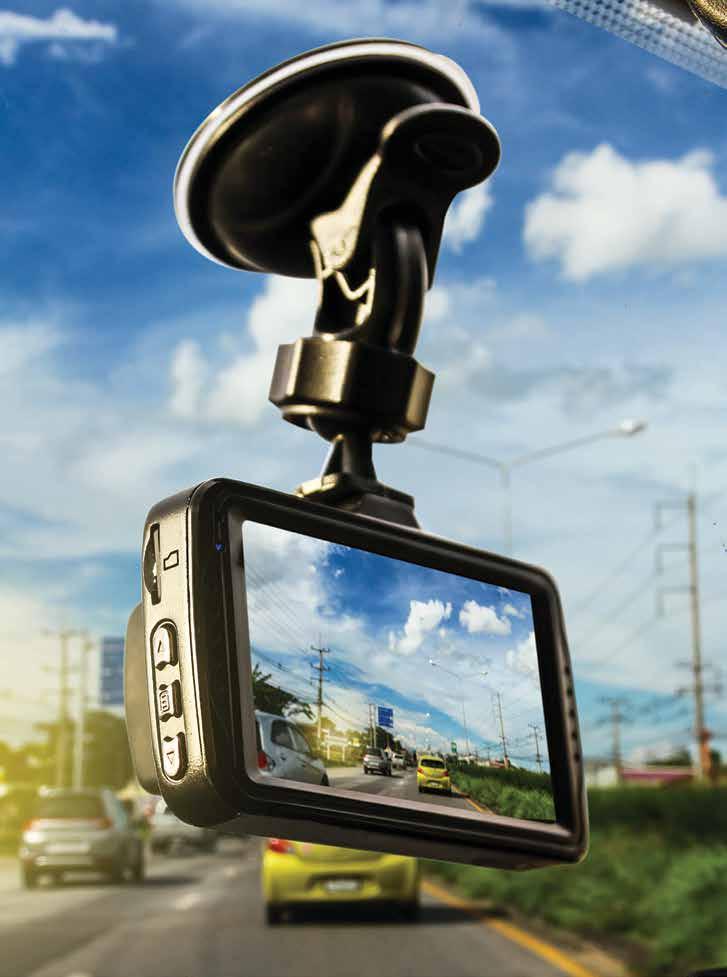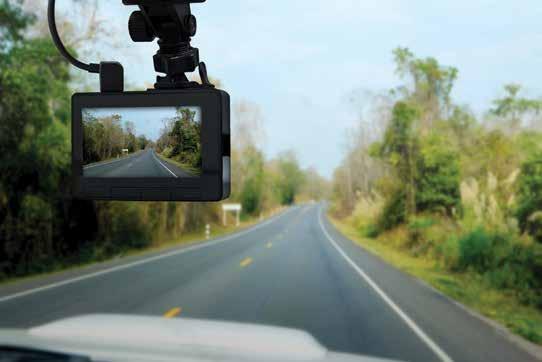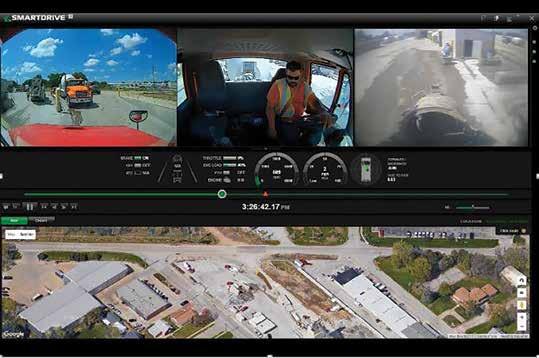
7 minute read
An Eye on Fleet Cameras: Can You Afford Not to Have Them?
An Eye on Fleet Cameras
Many Say Your Business Can’t Afford To NOT Have Them
Advertisement
By Amber Thurlo Pearson
We are in an era where if it wasn’t caught on camera, it didn’t happen, especially for our younger, technology born-and-bred generation. This mentality just may be helping fleets – and drivers – come around to heightened surveillance of their activity.


While privacy concerns may have been at the forefront when these video cameras first started rolling, now businesses – and drivers, are noticing that they can come out the victor if they get into a scrape – vehicular, or legal.
There are forward-facing and driver-facing cameras. The forward-facing focuses on the road, and can show what drivers around the truck are doing, and to an extent, what the driver is doing. Not only that, they have an analytics program that gets sent to the company, in most cases. This is known as video telematics. There are memory cards, which can be locked into the camera, so no fraud can occur after an incident. Or, increasingly, many systems are using cloud storage for the data.
Driving-facing cameras obviously monitor the driver and can show any nonadherence to laws or company rules, or negligence. Not only do both have serious implications in proving fault/innocence in accidents, but can also serve as, if nothing else, valuable training tools. “There must be someone back at the office processing through these videos, for the training aspect to be effective,” said Tom Hartman, VP/Safety Compliance of Commercial Fleet Data Systems, and 30-year law enforcement/state trooper veteran. “In the world we live in today, the cameras are a great tool to help you manage your risk. But once you have this data, you can’t NOT look at it and grow from it. If you don’t manage it, it can destroy you,” he said.
“You have to develop a program for reviewing the footage and what to do with it when there are concerns on a driver, for example, and have policies and procedures, and it be in writing,” Hartman said. “But they must also be followed – or they don’t exist,” he said.
“I highly recommend using cameras because they can help manage your loss runs, and help identify when the driver is in the right. We see people today trying to stage accidents to get money out of the trucks’ companies. These cameras will protect you 10 times
more than they will ever hurt you,” Hartman said.
“When people say, I’m afraid of the camera because what if it is our driver’s fault? Well, that’s also good to know right away; you can settle, manage your liability, and mitigate your loss. It can also be used as a training for a driver; you can make them better and correct for the future,” Hartman said.
THE INSURANCE PART
However, as alluded to before, often companies will initiate camera use due to liability. There are reports that there are predatory attorneys and predatory victims, even staging a minor accident with a fleet truck, and lining up their “witnesses” ahead of time.
“If someone calls and says hey, your driver cut me off, the camera has a memory card and it doesn’t lie,” said Lon Holloway, Northwest Propane. “We’ve dodged a bullet twice when the finger was pointed at us, due to the cameras. Especially in the Dallas metro area where we are, the traffic is quite intense, and in the last two years, once the officer actually saw our video on the scene and let us go, and another time we were also exonerated due to our video evidence. At the minimum, we avoided paying for $35,000 worth of damage that time.”
“In fact, we first had the forward-facing cameras installed when a driver accused that we cut them off. We had really appreciated the back-up cameras we had, which were our first foray into the cameras,” he said.
“Your truck is a rolling billboard for your company,” said Holloway. “If nothing else, you can see your driver on his or her phone, tailgating, or reaching into the floorboards, depending on which types of camera you have.”
Those who are opposed to implementing this technology cite privacy concerns, but in the end, many managers/owners just have to say that if the drivers don’t like it, they don’t have to work there. Owners need to think about what is best for their business, and how best to protect it. “The guy who barks the loudest is usually the one you need to watch. I say, ‘That’s my truck, not yours,’ ” Holloway said.
“All trucks should have forward facing cameras at least, I believe,” Hartman said. “Driver-facing can be very helpful, but is more a choice dependent on need, especially if it’s the owner/ operator’s truck. There’s the case for violating privacy. However, they can see phone use and smoking around potentially hazardous cargo,” he said.
And of course, guilt or innocence makes a huge difference in settlements and insurance. “We are seeing staged ‘accidents’ hap-
pen in larger cities like Houston and Atlanta, or near ports,” Hartman said. “I’ve heard reports of $125,000 settlements for little staged nudges, with ex-cons involved, but with no camera evidence, you can’t prove they were staged.”
The liability benefits range from lower premiums by having the cameras, to of course exoneration. “Video provides hard evidence when an incident occurs,”said Todd Buechler, AVP of Risk Engineering, Crum & Forster. “The majority of time and fees in transportation litigation are spent on gathering facts about what occurred – all of which could be eliminated with video evidence. Commercial drivers are often the victims of fraudulent claims, as well, and video provides unbiased evidence to prove when they’ve done everything right.”
SAFETY IS MORE THAN A FRINGE BENEFIT In chorus with all the interviewees in this story, Buechler said even if just to gauge the safe practices of the driver for training, it is important to note that management needs to manage the information and data and not ignore it. “Poor driving behaviors need to be addressed in a prompt and positive manner with documentation,” he said – sentiments that Hartman and Holloway both echoed. “Don’t just set it and forget it.”
“Vehicle accidents overall are increasing and so are the costs of vehicle accident claims,” Buechler said. “Companies have more difficulty hiring drivers and have to train less experienced drivers. So companies are looking for tools to assist them in managing their fleet exposure and reduce the risk of accidents. Overall, the use of video is positive. It provides fleet managers greater visibility into their drivers’ behaviors on the road and overall fleet operations. However, it’s important that video is actionable and accessible so fleets can get the most out of a video deployment, rather than creating more work for fleet managers,” he said.
COST
According to our interviewees, dash-camera prices average in the $100 to $300 range. “That’s nothing by today’s standards,” Holloway said. “One small accident can cost you $10,000, and insurance costs in this industry is at the highest level yet because of these cases. Insurance companies are paying because fighting them costs too much. Cameras will reduce insurance costs substantially. I heard a story of a guy who bought a $35 dash cam video and proved his own innocence,” he said.
Buechler added, “Return on investment (ROI) on these systems will vary for each company depending on a number of fac

tors, including past claims history. One of our partners, Lytx, says the ROI has proven well for many companies. For every $1 a fleet spends on a Lytx subscription, for example, they receive about $3-$6 back annually,” he said.
THE FUTURE
As mentioned earlier, Buechler notes, “Footage and data storage done in-vehicle on digital memory cards is being phased out and replaced by cloud-connected cameras that enable near realtime access to both live and historical video. This is an important move for the industry, as it brings with it greater efficiencies and ease of use, while eliminating a common barrier to adoption,” he said.
THE BOTTOM LINE
“For the industry today as a whole, having a safety management component is critical,” Hartman said. “Be proactive, not reactive. It has to start at the top and work down. You build a safety culture within your company, but you must educate and train everyone and get them on board. We have to manage risk every day. Risk management is a major component in transportation today, because of litigation,” he said.
“One unexpected benefit with the cameras is that if we have 25 drivers, we surely discovered that we didn’t have 25 perfect drivers, if nothing else” Holloway said. “We spend a lot of money on the trucks. With these cameras, one: you see what drivers are doing, and two: they just might save your hide in an accident. We’ve been very pleased with purchasing the cameras.”
“The back-office software (video telematics), forward-facing and rear-facing cameras have been a great investment for us,” he said. “I don’t know of one going bad for us, either, and they are relatively low cost. What safety tool could compete for $250, that sees what your driver is doing all day?”






